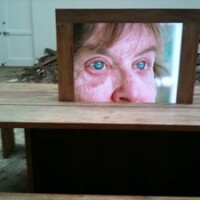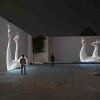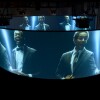Doug Aitken: Changing How We Relate to Art and the Environment

Over the past two decades, Los Angeles-based multidisciplinary artist Doug Aitken has earned international acclaim for his complex and engaging art projects that provide viewers with thought-provoking imagery concerning one of today's most socially and politically relevant topics: the increasingly perilous situation of planet Earth in our post-Industrial Revolution era. Through his innovative art works, Aitken invites viewers to consider the inherent conflicts between nature and technology and to reflect upon how urbanization affects the natural environment. Rather than simply take a photo or paint a picture to stimulate dialog about a particular issue, Aitken makes art that is experiential.
Up until the mid-twentieth century, viewing an artwork was a purely visual endeavor involving the simple act of looking. To enjoy a painting, we use our eyes to scan it from border to border. To engage with a monolithic sculpture, we can view it from the front, or we might walk all around it to see it from various angles. In these scenarios, we always interact with the artwork from a distance, as we are separated from the object spatially, a norm that is reinforced by the common museum signage used to assist in protecting a work from potential damage, which reads "Please Do Not Touch."
Aitken's art, by contrast, involves more than just looking; his approach reflects the late twentieth-century rise and widespread cultural legitimacy of the time-based mediums video, installation and performance art. Video art, although related to television and cinema in that it involves moving imagery, will often contain a narrative or sequence that is fragmented and non-linear. It may be presented in a continuous loop such that it keeps repeating over and over or be shown spread across multiple screens as part of a larger installation. Installation art may affect viewers in any number of ways. Because an installation usually occupies a room, or at least a section of it, or is spread across an outdoor landscape, it often requires that we physically move about, inspecting its various elements or reading any text that may be included. More often than not, a good installation will offer more than one thing to look at, while providing opportunities for journey and adventure. Similarly, while performance art is steeped in traditions of theater, and many do take the form of a cabaret-style presentation, a majority of performances occur not on a stage, but in a real-life setting. Many performances are also participatory, as in when the artist interacts with audience members, or, in the case of a performative installation, where the visitor becomes the performer by undertaking an activity. Aitken's most recent projects,” Underwater Pavilions,” “Mirage,” and “The Garden” are examples of immersive art that provides time-based experiences, conceptual equivalents of a viewer entering and traveling through the space of a painting.
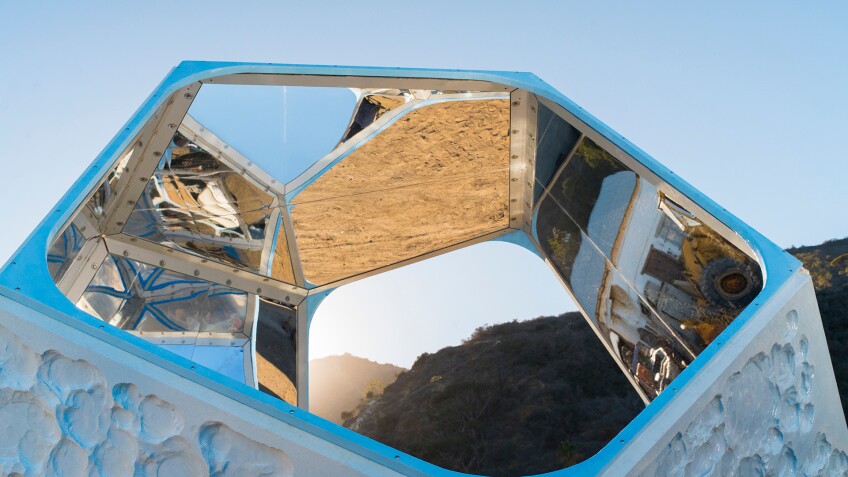
From the very beginning of his career, Aitken's artworks have involved exploration and journey. For his early single-channel video “monsoon,” Aitken traveled to Jonestown, Guyana, an area known for its monsoons as well as the site of the 1978 mass suicide by the cult leader Reverend Jim Jones and his followers. Seeking to capture the essence of this historically significant, environmentally-threatened locale, Aitken set out with his video camera to record a monsoon in action, yet the rains never came. Nevertheless, through a series of images and sounds presented on a single monitor, Aitken created a time-based visual tapestry that intersperses the colors, textures and rhythms of the area's jungles and tumultuous winds with traces of industrialization, such as abandoned trucks and tire piles. Correspondingly, the vivid contrasts between nature and industrialization are accompanied by the intermittent sounds of drones, birds and crickets. Such binary contrasts are an ongoing thread through Aitken's art and can be tied to his interest in entropy, the idea that everything in the universe tends to move from order to disorder.
Continuing to explore relationships between natural and urban landscapes, Aitken made the leap from the single-channel format to immersive installations involving multiple monitors, projections and speakers in the late 1990s. In “Diamond Sea,” he employed two projectors and multiple speakers to examine the world's largest and richest computer-controlled diamond mines in Namibia, South Africa. Seven screens were used for his next project, “Eraser,” which examines the environmental effects of a volcanic eruption on Montserrat Island a year after it occurred. Eight projections comprise “Electric Earth,” which explores the urban landscape through a visual mash-up of empty streets, human activities, fantasy, and reality, accompanied by a soundtrack of mechanical noises. When shown in 2016-17 as part of the artist's retrospective at the Museum of Contemporary Art, Los Angeles (MOCA), “Electric Earth” was presented on curving screens arranged in a circular formation.

While Aitken's installations of the late 1990s envelop the viewer and require us to move about to some extent, it wasn't until 2001 that the artist fully transformed the viewer's path through an exhibition into a bona fide physical journey. For his ambitious installation “New Ocean” at London's Serpentine Gallery, Aitken was offered the use of the entire building. As in previous works, he contrasted urban life with the forces of nature using photographs, film, and sounds. Visitors entered the exhibition through a workshop in the basement, worked their way upstairs and completed the journey on the roof, where a small cupola was converted into a lighthouse.
The installation's centerpiece was set up in one of the Serpentine's main galleries, where visitors encountered circular screens featuring dramatic images of the ocean, a subject for which Aitken has a particular fondness in that he was born in Redondo Beach and has lived near water for most of his life. With his recent project “Underwater Pavilions,” he moved from providing opportunities for virtual contact with aquatic imagery to offering up a novel situation where viewers can experience ocean-themed art by physical submersion in the ocean itself.
See how Doug Aitken's art has evolved through the years. Click through the timeline below:
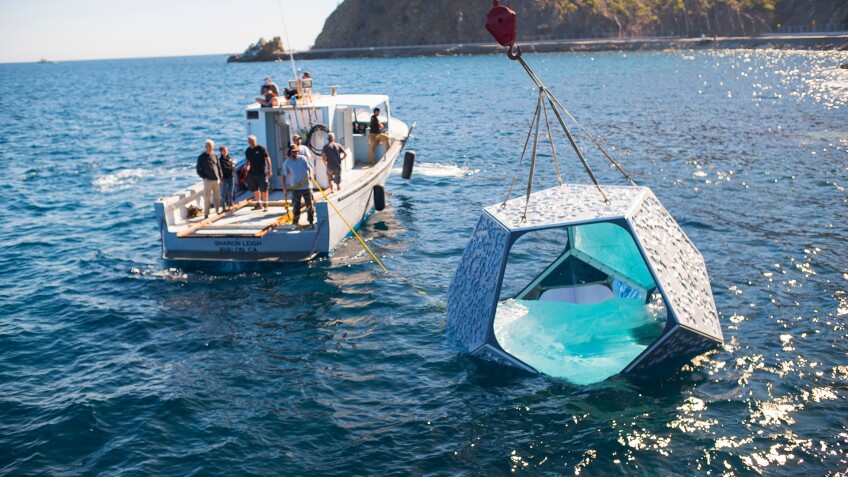
Produced in partnership with MOCA and Parley for the Oceans, a conservation group dedicated to protecting ocean life, “Underwater Pavilions” consists of three large geodesic sculptures that were installed underwater in a dive park off Catalina Island, such that swimmers, snorkelers and scuba divers could see the work up close. For those who don't swim or dive underwater, the installation can still be experienced virtually via live stream and recorded video from cameras attached to the sculptures.
To parallel the entropic nature of the larger universe, Aitken conceived the project so that visitors' close encounters with the sculptures would seem ephemeral and in flux. The pavilion’s interiors are lined with mirrors that facilitate a kaleidoscopic visual experience for swimmers as their reflections merge with images of surrounding fish, flora and fauna. Additionally, the artist worked closely with marine biologists to select a proper location that would cause no potential threat to the indigenous underwater inhabitants; He even textured the sculptures' outer surfaces to resemble rocks found in nature. With conservation in mind, the sculptures functioned as their own ecosystems; their overall goal being to heighten awareness of the declining health of the planet's oceans.

Invited in 2017 to participate in the exhibition "Desert X," a series of outdoor site-specific installations in the Coachella Valley, Aitken took his vision to the hills overlooking suburban Palm Springs. Continuing his efforts to heighten viewer perception of a surrounding environment, Aitken constructed a typical California ranch style home in an elevated open expanse of desert. Entitled “Mirage,” the structure was devoid of doors or windows with the interior walls and the entire exterior covered with mirrors. As in “Underwater Pavilions,” visitors once again experienced continuously changing kaleidoscopic imagery. In this case, it merged their own images with reflections of the architecture and the desert, an experience aimed at promoting thought and dialog about human connections to the natural environment.
Aitken's most recent project, “The Garden,” took the participatory aspect of an installation a step further. Located in a warehouse in Aarhus, Denmark, the installation consisted of a rectangular structure with two elements: a sterile, brightly lit glass room filled with white furniture and a misty and humid jungle of living plants living under grow lamps, which surrounded the glass room. As visitors walked through the installation, they could observe the stark contrast between a constructed synthetic environment and one that is organic and living. Additionally, they were invited to spend up to ten minutes in the glass room and annihilate its contents using implements provided by the artist, with their actions live-streamed across the Internet. In providing an activity for visitors at the center of an artwork about conflicts between nature and the environment, Aitken moved beyond simply providing a catalyst for thinking about the topic by offering a forum for reacting to it physically and emotionally. On another level, the destructive actions inside the glass room are a perfect metaphor for what humans have been doing to the planet.
Top Image: Doug Aitken's migration (empire), 2008. Installation view of Doug Aitken: Electric Earth, September 10, 2016–January 15, 2017 at The Geffen Contemporary at MOCA, courtesy of The Museum of Contemporary Art, Los Angeles | Joshua White
Timeline created by: Michael Naeimollah

